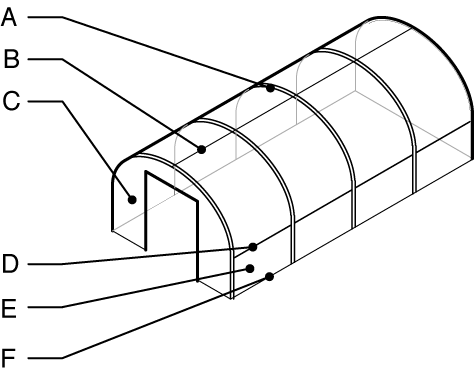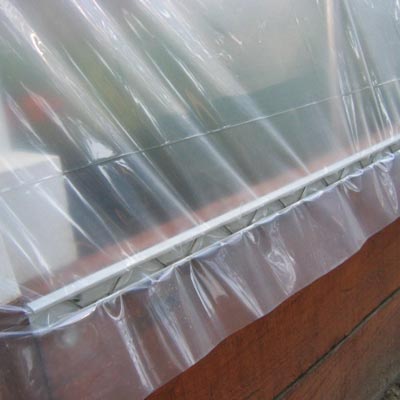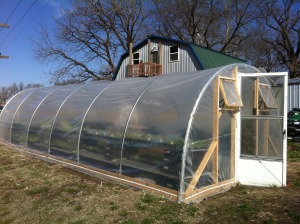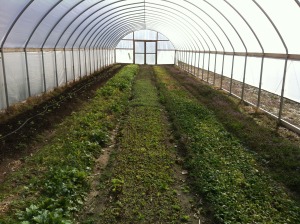Terminology & Diagram
The following diagram denotes basic terminology associated with high tunnel framework.
LINK: How to Build a High Tunnel, by Amanda Ferguson, University of Kentucky

- Rib, Hoop, Arch, Bow
- Purlin , Ridgepole
- End Wall
- Hip Board
- Side Wall
- Baseboard
Frame & Framing Materials
- The frame supports the structure and must withstand various stresses or “loads”
For more on Loads go to:
Orientation& Structural Concerns - To add strength to the structure, a number of strategies can be employed
- Drive posts 18 to 24 inches into the soil
- Use heavier gauge metal pipe for the ribs
- Add more than one purlin to the structure
- Decrease the spacing between the hoops
- Decreasing rib spacing from 5 feet to 3 feet intervals increases the amount of load that the structure can carry by 66%
- Fasten plastic glazing tightly to the structure
- The type and shape of the structure also influences its strength
- A gothic arched roof sheds snow better than aflatquonset roof, increasing structural carrying capacity by 15%
- The gothic arch can be achieved in high tunnel designs by bending the typical hoop shape with a pipe bender or bending jig
- No sidewalls or short sidewalls are stronger than structures with higher sidewalls
- A gothic arched roof sheds snow better than aflatquonset roof, increasing structural carrying capacity by 15%
- Metal pipe is the strongest framing material for rib construction
- Quality ranges from electrical conduit on the weakest end to 1.9 inch OD (outside diameter) thick steel or schedule 80 water pipe as strongest materials used
- Schedule 40 (3/4″ galvanized water pipe is commonly used but results in a 20% weaker structure compared to using Schedule 80 pipe)
- Metal ribs make the structure very heavy and difficult to maneuver
- PVC (polyvinylchloride) plastic pipe is an inexpensive material for rib construction
- This lowest cost material is one of the weakest
- PVC is lightweight and easy to maneuver
- High tunnels made from plastic hoops are vulnerable to wind uplift and snow load collapse
- PVC expands and contracts with temperature changes
- Wood is not typically used for rib construction, but is often a component of end walls, hip boards, and baseboard construction
- Treated lumber should be used for baseboards and any other wood that will come in contact with the soil
Covering Materials
Polyethylene
-

Picture courtesy of Farmtek.com
Greenhouse-grade polyethylene, a plastic film, is the most common material used for covering high tunnels
- “Poly” is sold by thickness in mils (1 mil = 1/1000 of an inch) and rated for longevity in years
- Typical specification for a high tunnel covering would be a single layer of greenhouse grade 6-mil poly rated for 5 years
- Traditional greenhouses usually have two layers of poly, separated by air blown between the layers, to reduce heat loss during cold season production
- Polyethylene glazing contains additives designed to enhance durability and performance, but these also increase cost and reduce light transmission
- Photosynthetic Active Radiation (PAR) is light that is utilized by the plant in photosynthesis and occurs in the 400-700nm wavelength range
- Ultra-Violet (UV) stabilizing additives block UV light to slow degradation and hardening of plastic
- Never purchase construction grade plastic because it does not contain a UV-inhibitor and will only last one growing season
- Anti-Fog surfactants makes poly covering less repellant to water
- Condensate will sheet and run down to the sides of the structure rather than bead and drop on foliage of plants below
- Condensation is undesirable because it decreases light intensity
- Infared (IR) heat blocking additives reduces radiant energy heat loss
- Polyethylene alone is a poor barrier to radiant energy loss, but IR treated poly can block IR heat loss by half, which is 15-25% of total heat loss at night
- A single layer of IR-absorbing poly decreases PAR transmission to 82%
- Photoselective films absorb or reflect a specific range of light wavelengths to manipulate plant growth
- For example, installing a poly with photoselectively that blocks 280-320 nm UV light, which is essential for sporulation of Botrytis cineraria may prevent this disease
Shade Cloth
 Shade cloth is made from knitted polyethylene strands or woven polyester, and it is water permeable
Shade cloth is made from knitted polyethylene strands or woven polyester, and it is water permeable- Shade cloth is used to reduce light intensity, temperature and plant exposure to wind
- Shade cloth is often used in combination with plastic covering but in some applications such as cut flower production in Southern California, it is used as the sole covering for a high tunnel
- Black, white and various shades of green and brown can be used
- White shade cloth may have a more profound cooling effect because it reflects more light than black and other darker colors of shade cloth
- Shade cloth is purchased by percent light blocked, 20-90% are commonly available
- Seasonal and crop species requirements dictate what percent shade cloth would be chosen
- For example, in spring little or no shade would be required for lettuce greens production: however, during the warmest summer months, 60% shade may be required to produce a quality product
- If used in conjunction with polyethylene, shade cloth may be installed on the inside or outside of the high tunnel
Attachment Techniques
- Secure attachment of the covering material is necessary to avoid tearing and excessive wear that shortens its longevity
- Fastening poly between two boards such as the hip board and batten board is the least expensive method
- However, this method may be the least secure, depending on the type of screws, spacing and installation technique
- Wiggle wire nestled in an aluminum channel offers continuous force along the surface of plastic and is relatively easy to install
- Wiggle wire is a continuously s-curving wire that is placed into the channel by “wiggling” it back and forth
- Many channel and clip systems are manufactured, including Poly Clip,Agrilock,andSurelock
- These are the most secure and most expensive poly attachment systems
- Some designs are reported to rip the plastic at the attachment site
End Wall and Side Wall Options
End Walls
 End walls offer access and ventilation for the high tunnel
End walls offer access and ventilation for the high tunnel- A major consideration for doors in the end wall design is ease of access
- Openings must be wide enough for a person to walk through with tools, supplies, or produce
- Large equipment access is also needed for roto-tiller, tractors, and other bulky equipment
- Door designs vary from manufactured storm doors, and sliding doors, to a non-framed plastic curtain
- To increase ventilation in the summer, some high tunnel designs utilize completely removable end wall sections
- If end walls are removable, sufficient structural support must be maintained
- Large screen sections, windows, and winged panels can also be installed in endwalls for summer ventilation
- If winter production is a goal, endwalls that minimize air leakage and accessibility during snow cover should be used
Side Walls
 Either fixed or roll-up side walls designs can be constructed
Either fixed or roll-up side walls designs can be constructed- Fixed side walls are applicable for winter production or in a climate where less ventilation is required
- Roll-up side walls offer a simple way to manage temperature and promote ventilation
- Ventilation is accomplished by rolling up the sides and allowing warm air to dissipate to the outside
- Temperature can be further manipulated by such actions as rolling up each side wall to different heights at different times of the day
- There are many designs for hand-powered handles and cranks that can be inexpensively installed to roll up the length of the plastic wall
- Purlin metal or fence toprail can be used for rolling up the length of the sidewalls




